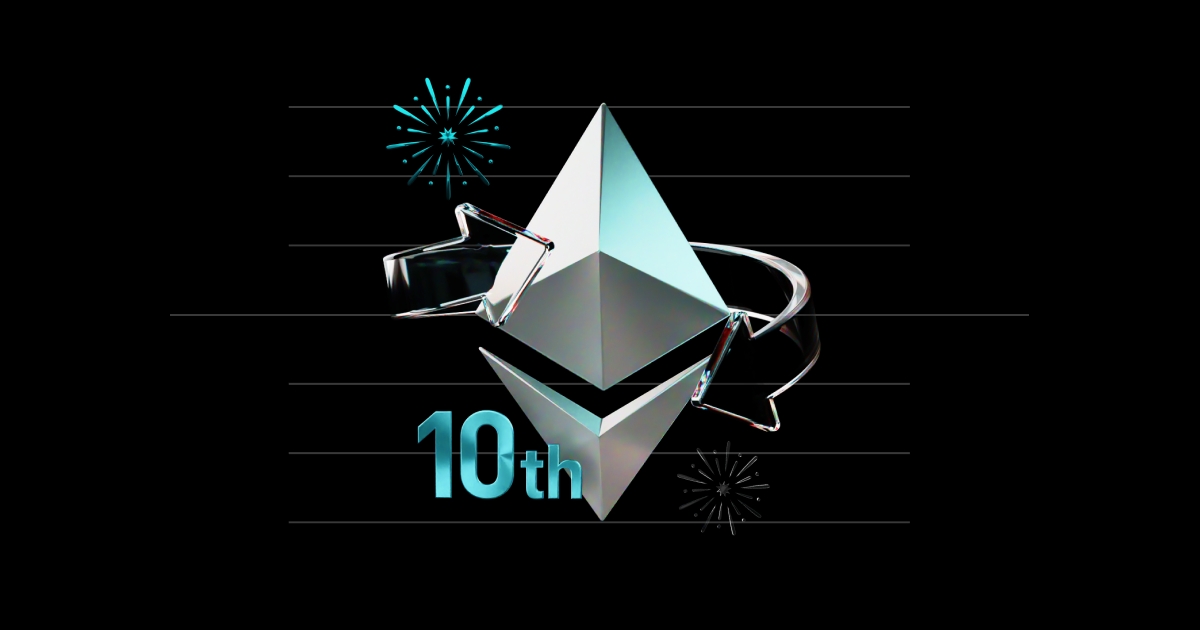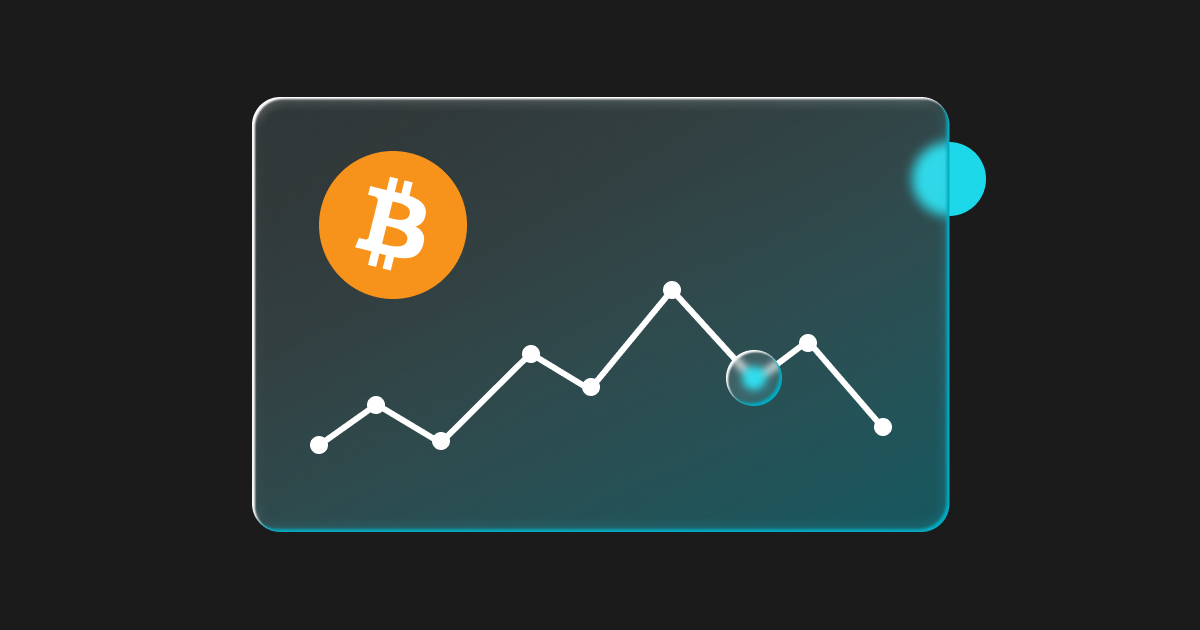
Ethereum at 10: The Numbers Behind a Decade of Digital Revolution
On July 30, 2015, at 15:26 UTC, block #1 was mined on the Ethereum network. The price? Around $0.40 per ETH. The total market cap? Less than $50 million. The ecosystem? A handful of developers and one ambitious vision.
Today, ETH trades above $3,700, the network processes daily trading volume averaged $17.2 billion in Q1 2025, and over 1.3 million developers build on the platform. This is the story of how an experimental "computer" became the backbone of modern decentralized finance.
The Price Evolution: From Experiment to Asset Class
Discovery Phase (2015-2017): Finding Product-Market Fit
Ethereum launched at $0.40 and spent its first year building credibility among early adopters. The breakthrough came in 2017 during the ICO boom, when hundreds of projects needed ETH to fund their token sales. This utility demand drove ETH from around $10 in early 2017 to a peak of $881 by December.
Milestone moment: 2016 marked ETH's first $1 billion market cap, establishing itself as the clear #2 cryptocurrency behind Bitcoin and proving smart contracts had real value.
The Builder Years (2018-2020): Infrastructure Over Speculation
The ICO bubble collapse sent ETH crashing to $83 by December 2018. While prices fell, serious builders arrived. MakerDAO, Uniswap, and Compound launched during this period, creating the foundation for decentralized finance.
Recovery catalyst: DeFi Summer 2020 introduced yield farming and liquidity mining, driving ETH from under $200 to over $700 as Total Value Locked grew from virtually zero to billions.
Peak Adoption (2021-2022): Mainstream Recognition
ETH hit its all-time high of $4,891 on November 16, 2021, powered by NFT mania, institutional adoption, and DeFi protocols managing over $100 billion. But the real achievement wasn't the price peak: it was executing The Merge in September 2022, transitioning from energy-intensive mining to efficient staking while processing billions in value.
Infrastructure Era (2023-2025): Institutional Foundation
The current cycle differs fundamentally from previous ones. Instead of retail speculation driving prices, institutional adoption powers growth: spot ETF approvals brought $6.2+ billion in inflows during 2025, while corporations now hold billions in ETH treasuries for operational use.
Present reality: ETH's 48% surge in July 2025 reflects institutional confidence in upcoming technical upgrades and real-world utility, not speculative fervor.

Source: CoinMarketCap
Technical Transformation: Building the Future One Upgrade at a Time
Foundation Era (2015-2019): Stability and Security
Frontier (July 2015): Genesis launch with basic smart contract functionality
Homestead (March 2016): Network stabilization enabling serious development
Byzantium (October 2017): Privacy features and economic adjustments
Constantinople (February 2019): Gas optimization and efficiency improvements
These early upgrades focused on making Ethereum reliable enough for developers to build businesses on top of it. The network grew from experimental curiosity to developer platform.
Economics Revolution (2020-2021): Changing the Game
Berlin (April 2021): Gas repricing and transaction improvements
London (August 2021): EIP-1559 introduced fee burning, fundamentally changing Ethereum's supply dynamics
EIP-1559 transformed Ethereum economics forever. Over 4 million ETH have been burned since implementation, making ETH potentially deflationary during high network usage periods. Users gained predictable fees while ETH holders benefited from reduced supply growth.
The Great Transition (2022-2024): Sustainability Achievement
The Merge (September 2022): Proof-of-Work to Proof-of-Stake transition reduced energy consumption by 99.95%
Shanghai/Capella (April 2023): Enabled staked ETH withdrawals, completing the staking cycle
Dencun (March 2024): Proto-danksharding dramatically reduced Layer 2 costs
The Merge stands as blockchain's most successful major protocol transition. Ethereum switched consensus mechanisms while processing billions in daily transactions with zero downtime: a technical achievement many thought impossible.
Scaling Era (2025-2026): Global Infrastructure
Pectra (Expected May 2025): Account abstraction making crypto wallets as easy as apps
Fusaka/Fulu (Late 2025): Verkle trees enabling stateless clients
Future upgrades: Full sharding targeting 100,000+ TPS by 2026
Each upgrade builds toward Ethereum handling internet-scale transaction volumes while maintaining decentralization and security.
The Scaling Revolution: Making Ethereum Accessible
Ethereum's scaling solution wasn't to change the base layer fundamentally, but to build sophisticated infrastructure on top of it. Layer 2 networks transformed the user experience from expensive and slow to cheap and instant.
Performance Transformation
Then (2021): $50+ transaction fees during network congestion
Now (2025): $0.03 on mainnet, under $0.01 on Layer 2s
This 5,000x cost reduction while maintaining security enabled entirely new use cases: gaming economies, social networks, and micropayments that were previously impossible.
Layer 2 Ecosystem Leaders
● Arbitrum: 4,000+ TPS processing 30%+ of L2 activity
● Optimism: Powers 60% of L2 transactions through its Superchain vision
● Polygon: Supports 28,000+ contract creators across its ecosystem
These networks maintain Ethereum's security guarantees while offering the speed and affordability needed for mainstream adoption.
Network Growth: The Scale of Success
Developer Ecosystem Explosion
2015: Dozens of experimental developers
2025: 1.3+ million active developers (largest in crypto)
Current metrics:
● Live applications: 4,000+ dApps across all categories
● GitHub activity: 87,327+ commits from 1,300+ regular contributors
● Market share: 65% of smart contract platform activity
Transaction Volume Growth
2015: Thousands of transactions daily
2025: 1.64 million daily transactions (46% increase year-over-year)
This growth occurred while transaction costs plummeted, proving Ethereum solved the scalability challenge through Layer 2 innovation.
DeFi Maturation: From Experiment to Infrastructure
The decentralized finance ecosystem evolved from curiosity to critical financial infrastructure serving institutions and individuals globally.
Leading Protocol Growth
● Lido: $33 billion in liquid staking, democratizing ETH staking access
● Aave: $11 billion enabling permissionless lending and borrowing
● Uniswap: $4.8 billion facilitating decentralized trading
Market Impact
Total DeFi TVL: $86+ billion representing 60% of global decentralized finance value
These protocols now rival traditional financial institutions in assets under management while offering 24/7 global access without geographic restrictions.
Institutional Adoption: Wall Street Embraces Ethereum
Corporate Treasury Revolution
BitMine Immersion Technologies: $1+ billion in ETH holdings
SharpLink Gaming: $840 million actively staked for yield
Multiple public companies: Using ETH for operations, not just speculation
Financial Services Integration
● ETF success: $6.2+ billion institutional inflows in 2025 alone
● Enterprise adoption: Microsoft, J.P. Morgan, EY building production systems
● Payment infrastructure: Cross-border settlements and stablecoin rails
Real-World Asset Growth
Current tokenization: $6.5+ billion in traditional assets on Ethereum
Applications: Government bonds, real estate, commodities, corporate shares
This represents the beginning of traditional finance migrating to blockchain infrastructure for efficiency and global accessibility.

Source: ainvest.com
Ecosystem Innovation: Beyond Financial Services
NFT Market Evolution
Then (2017): CryptoPunks as digital collectibles experiment
Now (2025): $6.4 billion market focused on utility, gaming, and digital identity
The NFT space matured from speculation to practical applications: gaming assets players truly own, digital identity systems users control, and brand engagement tools that create direct creator-fan relationships.
Gaming and Virtual Economies
● Asset ownership: Players own in-game items across different platforms
● Creator economies: New monetization models for digital content creators
● Cross-platform compatibility: Items usable across multiple games and applications
Competitive Landscape: Leading Through Innovation
Despite intense competition from Solana's speed, Cardano's academic approach, and Binance Smart Chain's mass adoption, Ethereum maintains leadership through continuous innovation and network effects.
Sustained Advantages
● Security leadership: Largest validator network with longest track record
● Developer preference: Most active ecosystem and strongest network effects
● Institutional trust: Clear regulatory status and enterprise adoption
● Technical innovation: Regular upgrades maintaining technological edge
Rather than competing on single metrics like speed or cost, Ethereum optimized for the combination of security, decentralization, and innovation that institutions and serious builders require.
Looking Forward: The Next Decade Vision
Technical Roadmap (2025-2030)
● Sharding implementation: 100,000+ TPS supporting global scale applications
● Zero-knowledge integration: Privacy and scaling breakthroughs for mainstream adoption
● Quantum resistance: Post-quantum cryptography protecting long-term security
● Cross-chain infrastructure: Seamless multi-blockchain experience
Market Evolution Drivers
Institutional allocation: More corporate and fund adoption for treasury management
DeFi-TradFi convergence: Traditional finance adopting blockchain infrastructure
Global payment rails: Cross-border commerce and settlement systems
Innovation acceleration: New applications and use cases driving adoption
Price targets for 2030 range from $6,000-$17,000, though the focus has shifted from speculation to fundamental utility metrics and adoption indicators.
Anniversary Reflection: What 10 Years Built
Vitalik Buterin's original vision called Ethereum a "decentralized platform that runs smart contracts." By that definition, the mission succeeded beyond anyone's expectations. But examining the transformation from 2015 to 2025 reveals something even more significant: Ethereum became the foundation for an entirely new economic system.

Source: Crypto-economy
The transformation metrics:
● From: $0.40 per ETH To: $3,700+ per ETH (9,250x growth)
● From: $50 million market cap To: $450+ billion market cap
● From: Handful of developers To: 1.3+ million active developers
● From: Experimental concept To: $1.4 trillion annual transaction volume
Yet perhaps the most important achievement is resilience. Ethereum survived multiple bear markets, technical challenges, regulatory uncertainty, and existential threats like The DAO hack. Each obstacle strengthened the foundation and expanded the community.
The Community Achievement
Beyond technical metrics, Ethereum's greatest success lies in building a global community united around shared values: decentralization, permissionless innovation, and financial sovereignty. This community made hard decisions during crises, funded public goods, and maintained focus on long-term value creation over short-term gains.
The developer community that started with dozens of experimenters now includes major corporations, academic institutions, and millions of individual contributors. This network effect creates a self-reinforcing cycle of innovation and adoption.
Challenges and Opportunities Ahead
The next decade will test Ethereum's ability to scale while maintaining its core principles:
● Technical delivery: Executing ambitious roadmap promises under global scrutiny
● Regulatory navigation: Achieving compliance without compromising decentralization
● Global adoption: Serving billions of users across diverse economic and political systems
● Sustainable growth: Balancing innovation speed with security and stability
The Next Chapter Begins
As Ethereum celebrates its 10th anniversary, the platform stands at an inflection point. The experimental phase ended with The Merge. The infrastructure phase has begun.
The next decade will determine whether Ethereum becomes the settlement layer for global digital commerce or remains one option among many. Current trends point toward the former: institutional adoption accelerating, technical capabilities expanding, and real-world use cases multiplying daily.
For developers, investors, and users, Ethereum's 10th anniversary marks not an ending, but a beginning. The foundation has been built. Now comes the construction of everything else.
The revolution that began with a teenager's whitepaper continues, powered by a global community building the future of human coordination and economic interaction.
Trade ETH on Bitget!
Learn More About ETH
Whether you're new to Ethereum or looking to deepen your understanding, explore these comprehensive guides:
● What Is Ethereum? Ultimate Crypto Guide - Complete overview of Ethereum fundamentals and evolution
● Ethereum Price Forecast 2030 - In-depth analysis of ETH's long-term potential
● How Gas Fees Work on Ethereum - Practical guide to understanding and optimizing transaction costs
● Ethereum ETF Explained - Everything about institutional ETH investment vehicles
Ready to dive deeper? Access the complete Ethereum education library featuring tutorials, market analysis, and expert insights to navigate the next decade of blockchain innovation.
Investment involves risk. Past performance does not indicate future results. Please conduct your own research and consider your risk tolerance before making investment decisions.



